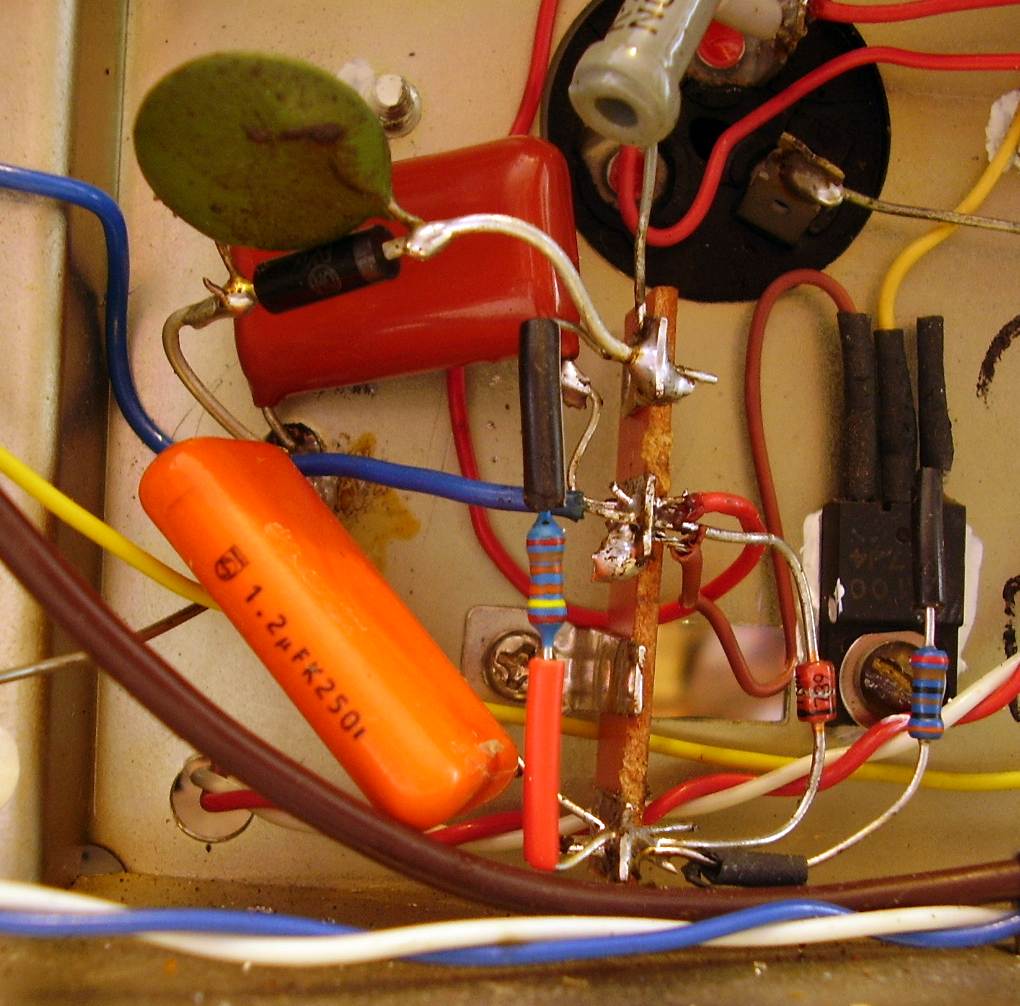1. Original design
Lafayette HE-30 (similar to Trio 9R-59) is a basic single conversion tube semi-professional short wave communications receiver. It covers 0.55 to 30 MHz in four bands. It has bandspread function by way of a small variable capacitor connected to each gang of the maim tuning variable capacitor.
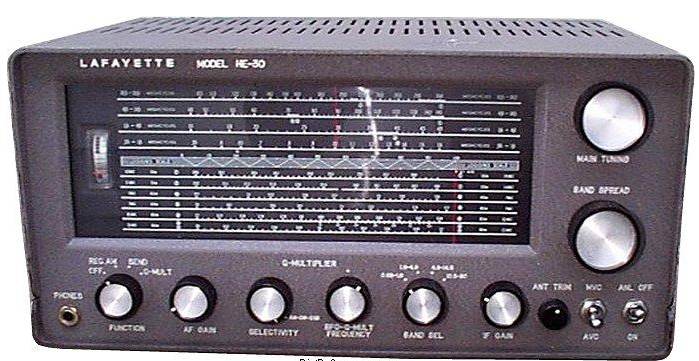
As many other similar designs, it has one RF stage (6BA6), local oscillator (6BE6 in triode), mixer (6BE6), two IF stages (6BA6), AM detector and first audio (6AV6), output audio (6AQ5), rectifier (5CG4). This model also has a Q-multiplier (6AV6) which can work as a BFO if driven into continuous oscillation. BFO signal is injected into the 1-st IF input via stray coupling.
You can download original HE-30 schematic here.
You can download full HE-30 operating manual here.
Original HE-30 receiver has several drawbacks. To name a few, it has less than desired frequency stability at the top band, low audio quality, and almost useless Q-multiplier. Some simple modifications, described below, can greatly improve performance of this vintage radio.
2. Voltage regulator
In the original design all the LO, mixer, IF stages, Q-multiplier and even the screen of the output audio stage are powered by an unregulated voltage about 110...140V. Needless to say, local oscillator frequency depends on the mains voltage -- frequency sometimes jumps with turning on of an air conditioner or a microwave oven in the household. Sometimes signal strength affects the LO frequency. Automatic gain control changes current draw of the RF anf IF stages, which causes LO supply voltage to change -- hence frequency drifts. Besides, unregulated voltage supply to the IF counteracts AGC operation.
Adding a voltage regulator for the RF, LO and IF stages solves the above problems. An example of such a regulator is shown below.
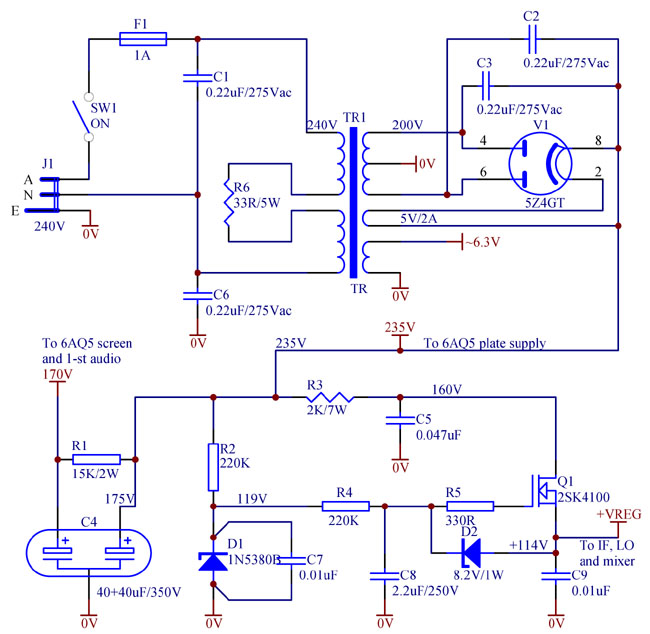
Regulated voltage of about 114V is close to optimum. A Zener diode is used as a reference. A high transconductance Q1 MOSFET 2SK4100 provides good load regulation. Suppressor resistor R5 is essential. It shall be connected directly to the gate pin of Q1. Another Zener D2 is for the MOSFET protection. R4C8 filters Zener noise and ripple.
High voltage Zener diodes are very noisy in the wide frequency band. For that reason, to filter RF component of the noise it is very important to connect a shunting low inductance disk ceramic capacitor C7 as close as practical to the Zener body and on the shortest leads, for example, as shown in the picture below.
It is also advisable to mount the Zener D1 away from the sensitive RF or IF nodes, to avoid the residual noise leakage into the receiver signal or IF path. In the given example the regulator is located in the corner of the chassis near the phones connector -- far away from any RF circuity. It is very convenient to choose Q1 MOSFET in a fully insulated TO-220F package and mount it directly to the chassis for a heat sink.
Now when the HF stages get regulated supply, the other section of the C4 electrolytic capacitor can be used solely for filtering of the supply to the AF amplifier: the first stage (6AV6) and the screen grid of the output stage (6AQ5) . Filtering resistor R1 can now be larger, giving an excellent hum reduction. Besides a higher voltage (175V as compared to the original 110V) is available on the 6AQ5 screen grid, which increases audio output power.
It is also recommended to replace the original 5CG4 rectifier with a 5Z4GT, which has a lower voltage drop, or even with the silicon diodes 1N4007. C1, C2, C3, C6 are optional to reduce the modulation hum (tuned hum), but with the vacuum rectifier it is virtually non-existent anyway. An optional dropping resistor R6 may be used if the mains voltage is consistently higher than nominal, like say in Australia, where it is usually 240...250Vac most of the time.
3. AM detector
In the original HE-30 design the AM detector is AC loaded by the AGC filter R18C3. It limits the maximum undistorted modulation handled to about 75%, while nowadays MW and SW broadcast stations use up to 100% modulation. A relatively large loading capacitor C20 (100pF) further contributes to distortion at higher AF frequencies.
To improve audio quality it is recommended to:
- separate AGC detector and audio AM detector;
- reduce capacitive loading on the AM detector;
- use a sensitive Schottky diode instead of a vacuum detector (6AV6).
A picture below illustrates these changes.
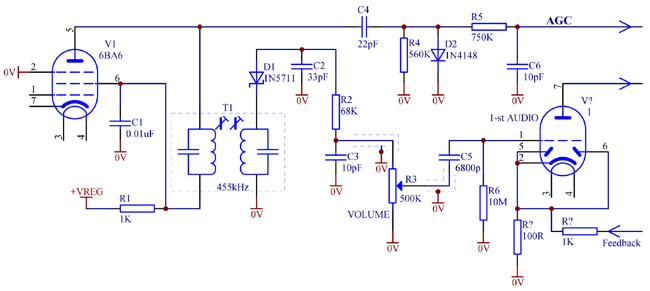
A 1N5711 Schottky diode in fact has so small "knee" (about 50mV at those sub-microamp currents) that it works better than a vacuum diode at low IF levels. Its low capacitance (1.5pF) helps reduce IF losses in C2. Capacitor C3 may be omitted, as the capacitance of the shielded cable to the volume control potentiometer gives enough filtering. A small "knee" of about 0.5V of the AGC detector silicon diode D2 provides a mildly "delayed" AGC action. Total grid leakage R4+R5 resistance is lower than the original 2.2M, which makes the circuit more forgiving to old and gassy tubes. Besides, now the diodes in 6AV6 are no longer used, hence the cathode of 6AV6 can be lifted of the ground and can be used for a negative feedback from the secondary winding of the output audio transformer.
4. Q-multiplier / notch filter
A Q-multiplier, which was intended originally to pull weak ham AM signals, in modern days is almost useless. It narrows down the bandwidth, making the sound of the AM stations even more "low" and muffled. Besides a Q-multiplier working close to the oscillation point is prone to distortion, "ringing" and instability.
To reduce interference, it is far better to suppress an interfering signal, rather than peak on the signal of interest.
AM detector is fundamentally a non-linear device. If two signals are present at its input, on the output there will be not a sum of both demodulated envelopes. Instead, a stronger signal suppresses a weaker one. Suppose the weaker one is the interfering signal. It will turn into a "whistle" or a "monkey-chatter". At the same time, the weaker interference signal becomes a "floor" for negative modulation excursions of the signal of interest. Thus an interference does not only add to the signal of interest as a "whistle", but it also limits and distorts the main signal. For that reason such interference can not be simply removed at audio frequencies by a treble tone control or an audio notch filter. Such technique might reduce the "whistle" but will not eliminate distortion and partial loss of the signal of interest.
It is more useful to try to remove the interference in front of an AM detector. A narrow-band notch filter can be used for such purpose.
Converting a HE-30 original Q-multiplier into a notch filter is easy -- one has to couple a Q-multiplier to an IF tank not in parallel, but through a small (15...22pF) series capacitor. In this case, a sharply tuned Q-multiplier LC tank at its resonant frequency will start to "suck" energy from the IF path, creating a notch.
An implementation of such a notch filter is shown below.
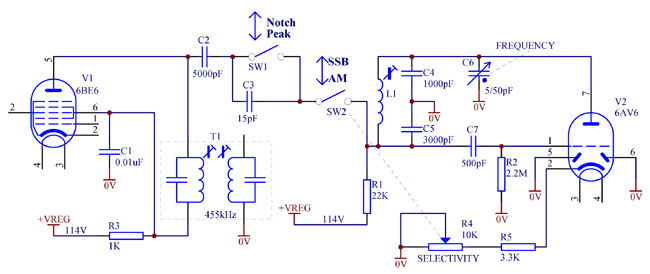
Original circuit, mounted in an enclosed metal compartment, does not change. Connection to the IF transformer changes. To switch between the normal peaking mode and new notch mode, a former noise limiter ON/OFF switch (SW1) can be used. When C3 is bypassed, the Q-multiplier works in the normal peaking mode, when C3 is in circuit -- in the notch mode.
5. Eliminating RF stage parasitic self-oscillation / instability
Sometimes RF amplifier in Lafayette HE-30 communication receiver becomes unstable and self-oscillates. Such parasitic oscillation usually manifests itself when adjusting the "Antenna trim" control, touching antenna connector or attempting to tune slugs and trimmer capacitors of the RF stage. Its symptoms are abrupt, intermittent and inconsistent abnormal noise level jumps, suspiciously sharp peaking of antenna trimming, crackling, whining, buzzing, hum, excessive microphonics, loss of reception, etc.
Usually such oscillation occurs in the middle of band 4 -- between 12 and 20MHz -- when antenna cable is unplugged and thus the antenna input LC tank Q is not damped by antenna impedance and with IF/RF gain control set to maximum. Band 3 also can be affected by this "disease", but not that often as band 4.
The cause of such problem is not apparent. Improving cathode and plate circuit bypassing and decoupling of the 6BA6 based RF stage does not help (though shortening the leads of 0.01uF disc ceramic decoupling capacitors helps marginally), so it is not a circuit design issue.
Additional shielding and separation of 6BA6 grid and plate circuitry, replacement of the tube does not change anything, so it is not stray or interelectrode capacitance to blame.
Extending aluminium coil separation partitions, inserting additional bridging metal plates to isolate, enclose and magnetically shield the coils has no effect. So magnetic coupling of the RF and antenna coils is not the root of the problem either.
Reducing RF gain, for example, by fitting a remote cut-off pentode with lower transconductance, such as 6К1П (or 9003, 6K1P), provided the socket is rewired to connect pins 2 an 7, can cure the oscillation problem, but sensitivity of the already noisy receiver suffers. The same "cure" can be achieved simply by fitting a larger (470...1000 Ohm) self-bias resistor in the cathode of RF amplifier.
So all the above tests lead to conclusion that some obscure evasive coupling between input and output of the RF stage does take place and causes the instability, but where exactly is this parasitic feedback path?
Cause of the problem
Further investigation and analysis shows that the spurious coupling between the RF stage plate LC tank and grid antenna tank happens through the common parasitic grounding impedance of the shaft, sliding contacts and grounding braided straps of the gang tuning capacitor. Due to this impedance, the shaft (rotor) appears not fully earthed. RF current circulating in the plate RF LC tank induces some voltage on the rotor assembly, which voltage consequently gets injected into the antenna tank. Further there is a reason to believe, that ohmic resistance of the rotor grounding, rather than shaft inductance, contribute to the said impedance.
As a receiver gets older, earthing sliding contacts in the triple-gang capacitor wear out, get dirtier and lose tension, which results in the contact resistance increase. Braided earthing straps (and possibly mounting screws) get oxidated, tarnished or surface-corroded, which, due to skin effect, also increases the grounding impedance at higher frequencies. As a result, older Lafayette HE-30 receivers, and possibly others, like Trio 9R-59DS, are more likely to suffer from this RF oscillation syndrome. By the way, all three LC tanks on the shaft of the triple-gang capacitor get coupled, which explains why local oscillator frequency is sometimes affected by the "Antenna trim" control.
Cure
The easiest practical treatment is to arrange an external coupling between the plate and grid tanks, equal in magnitude, but opposite in phase to the offending spurious coupling. The following pictures illustrate the technique.
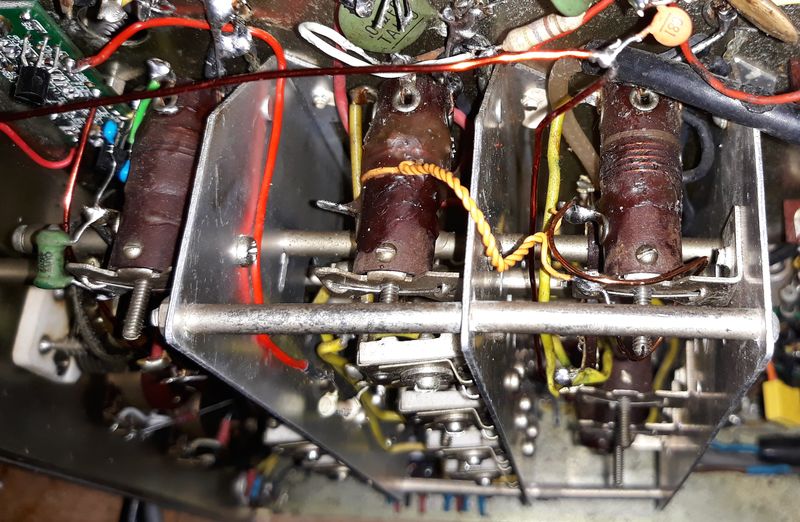
External loop coupling is introduced between RF and antenna LC tanks. One turn is placed on the former of the RF coil, twisted "feeder" runs into antenna coil compartment, loose turn of enamelled wire is created around the antenna coil. Polarity and magnitude of the coupling is determined empirically. Coupling strength is adjusted by moving the loops closer or further away from the coils. However it is more practical to fix one of the loops (on the RF tank in this case) in place by wax, make the other loop flexible and "massage" it to achieve a desired level of coupling. The "feeder" between the loops is the same insulated wire (yellow in the photos) from which the first loop is made -- closely twisted to reduce leakage inductance of the "feeder".
The next picture illustrates how the secondary loose loop around the antenna coil is made from 1mm enamelled copper wire and soldered between a lug on the coil former and the metal mounting bracket.
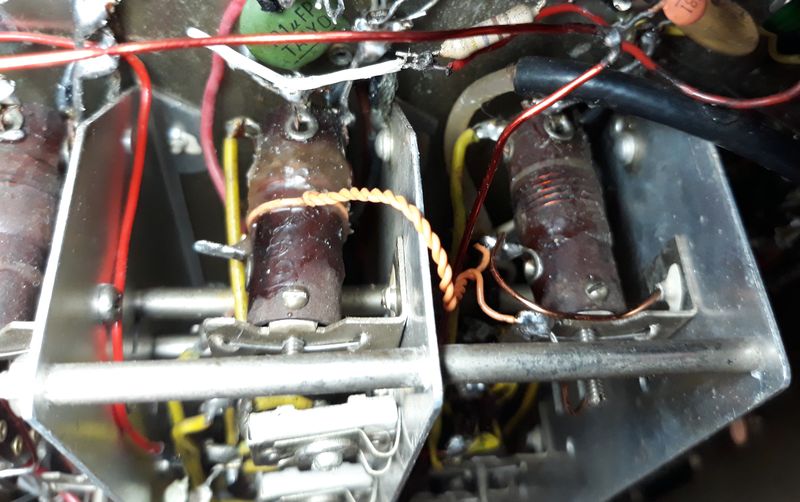
Secondary loop is loose and made of 1mm copper enamel wire to be flexible. Making the loop larger and bending it further away from the coil reduces the coupling, and vice versa.
In the next close-up, the secondary loop does not look like a circular loop at all. It is distorted, flattened and bent away from the antenna coil winding.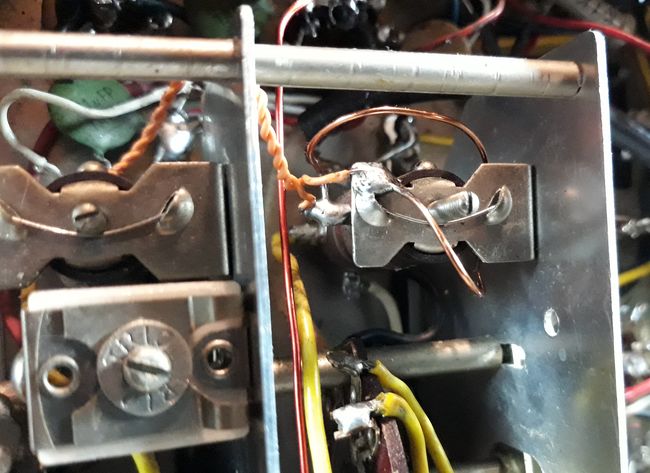
That was done apparently in attempt to reduce coupling to some optimum level. Alternatively, to get a neater look, both loops can be made like the primary one -- as a single tight turn. Then coupling factor can be adjusted by sliding the loops along both coil formers. It may become problematic, as the lugs on the coil formers are in the way. Yet another coupling control method is inserting a variable inductor in series with the loop. This may not be practical too, as it requires to have assorted inductors in 0.5...5uH range at hand.
Adjustment procedure
1) Note that frequency range where the parasitic oscillation is the most "violent", that is occurs at the lowest IF/RF gain control setting of the radio.
2) Make the primary loop with a twisted "feeder" from a single-strand insulated wire and fix it on the RF coil former with wax, as shown in the photos above.
3) By relocating 100pF grid decoupling capacitor, free the solder lug on the antenna coil former. Tin the corner of the coil mounting bracket and solder the "feeder" to these two respective anchor points.
4) Prepare a secondary loop from approximately 0.8...1.3mm enamelled copper wire. Too thin will be flimsy, too thick -- too stiff to bend. Solder this secondary loop between the bracket and the lug.
5) Remove (pull out from socket) the RF stage 6BA6 tube, tune the radio to the "worst case" frequency, determined at step (1) and apply some strong signal at this frequency to the antenna input, so that you can actually receive this signal without the RF stage only through the parasitic coupling between antenna and RF coils. For example, a fluoro table lamp with antenna wire loosely wrapped around the fluoro globe will be a perfect source of strong wide-band noise. An brushed electric motor, for instance in a shaver can do the job too.
6) Now the aim is to "massage" the secondary loop in such a way to minimise leakage of that noise -- to make the noise sound as quiet as possible. First of all, polarity or direction of the secondary loop connection shall be established so that it actually reduces (cancels) the noise, not increases it. If the loop makes the noise only stronger, its polarity should be reversed. Then the loop should be gently moved and/or bent spatially to find a position where the noise leakage reaches the minimum. Use some dielectric implement to bend the loop. This minimum should be quite distinct, like tuning a notch filter. The loop should be left in the position of the best cancellation or in slightly under-compensated position, but not over-compensated.
Once the above adjustment is complete, RF stage tube can be plugged back in, and hopefully the receiver will rid of the oscillation problem. However, in some severe cases, after the above treatment the RF instability might start manifesting at some other frequency, typically higher. This is because such compensation, unfortunately, is frequency dependent and does not cover all the band. It works well only around a certain frequency. Therefore, if after this treatment parasitic oscillation will reappear at some other frequency, the procedure shall be repeated -- at a frequency somewhere between the original worst case and a new problematic point. Second iteration is quite easy as the loops are already installed, and only a little more bending will be needed.

